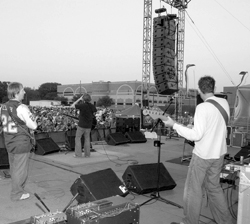
Our production manager for the festival spent each day traveling between stages, providing a break to a beleaguered engineer here, dealing with a power problem there, handling a recalcitrant band engineer somewhere else. He also carried a radio for instantaneous contact. And, this person must have healthy legs – in a very crowded festival, a golf cart won’t work!
Three weeks out, we assembled packets for all of the subcontractors involved. These included parking passes and wristbands, a map of the campus showing all stages and parking areas, a complete schedule of the event, and for the sound providers, stage plots and input lists. Load-in times were also provided.
Scheduling personnel is critical at this point. We staggered the load-in times so that we could make the best use of our stagehands. Stagehands have a four-hour minimum, and each is usually scheduled to work at more than one stage during a shift. For load-out, we scheduled a much larger number of stagehands. This schedule was then filed with the labor company as a written work order, and note that this also included spotlight operators as well.
IT’S SHOWTIME!
Two days before the festival, we began to build the stages. The provider arrived with semi-trucks loaded with staging, and we again walked the site with the festival director, spotting the stages, front-of-house risers, spot towers and security towers.
The day prior to opening, we loaded in at our two stages, which then left us free to address the mayhem of everyone else loading in the next morning. The lighting contractor also loaded in with us in order to be out of the way, and this left the lighting directors free to work with headliners who might arrive early. On-site security was continuous at this point.
Day one of the festival would arrive, and we were free to conduct headliner soundchecks on our stages. Fortunately, the first act didn’t begin until 6 pm, so the atmosphere wasn’t too stressful.
The production manager was also available to address the various surprises that unfold, as they invariably will. This is where months of planning pay off and you can look really good to the client, who’s running around putting out all kinds of fires while his production people are calmly doing their jobs.
If all subcontractors are competent and well prepared, the event should run like an average one-off show. One caveat, however: it’s still a multi-day, multi-stage festival, with thousands of people swarming all over, so competent, well-informed stage managers become critical to your existence.
They aren’t needed to get artists on and off the stage – we had already planned that out. They are most definitely needed to competently answer artist questions – “Where are our food coupons?” and “Where is our dressing room?” and the like. They also kept lots of water on ice, and plenty of ice in the ice chests.
The most important thing stage managers did, however, was manage the radios. Each stage had a radio, as did the production manager and the lead backline technician, and they were on a common channel with the event director.
As the production staff performed its various tasks, we didn’t have time to monitor a radio, but when we had a problem or needed help, we simply asked a stage manager to contact whomever we needed. Previously we carried individual radios, but learned that this alternative approach worked so much better for everyone, plus it gave the stage managers a sense of ownership of their jobs as well.
The best advice: “be round.” Roll with the punches and don’t get too excited by the inevitable little surprises that spring up. Make the production of entertainment as smooth as possible and don’t create tension or problems. That’s a big reason you were hired!
THE AFTERMATH
When it’s all over, the results of diligent planning and scheduling should continue to pay off. We found that handling a large number of stagehands at the end of the festival worked best if we arranged for the crew chief to assemble all of them at a pre-arranged site and make assignments from there.
Stagehands were first dispatched to the stages manned by our subcontractors, then re-routed to our stages last. We always got this show loaded out within our four-hour labor minimum, by the way.
The production manager continued to make a circuit of the stages, being sure each stage had its allotted stagehands and collecting any left-behind belongings. We later attempted to repatriate these items with their owners.
When all the dust cleared a week or two later, we sat down and created a recap of the event, and this went into the file for next year. We also sent this recap to the festival director. Included were a summary of any issues that came up, general incidents, what worked well and what didn’t, and suggestions for improving next year’s event.
By working with the client in this fashion, we made ourselves a part of the event team, and enjoyed a multi-year contract. We also ingratiated ourselves to our subcontracting partners, who appreciated the work and reciprocated when appropriate.
It’s just good business to develop this kind of working relationship with your clients and fellow business people, and it leaves you feeling pretty good about yourself as well.
Teri Hogan is a long-time audio professional and was co-owner of Sound Services Inc., a sound company based in Texas.
